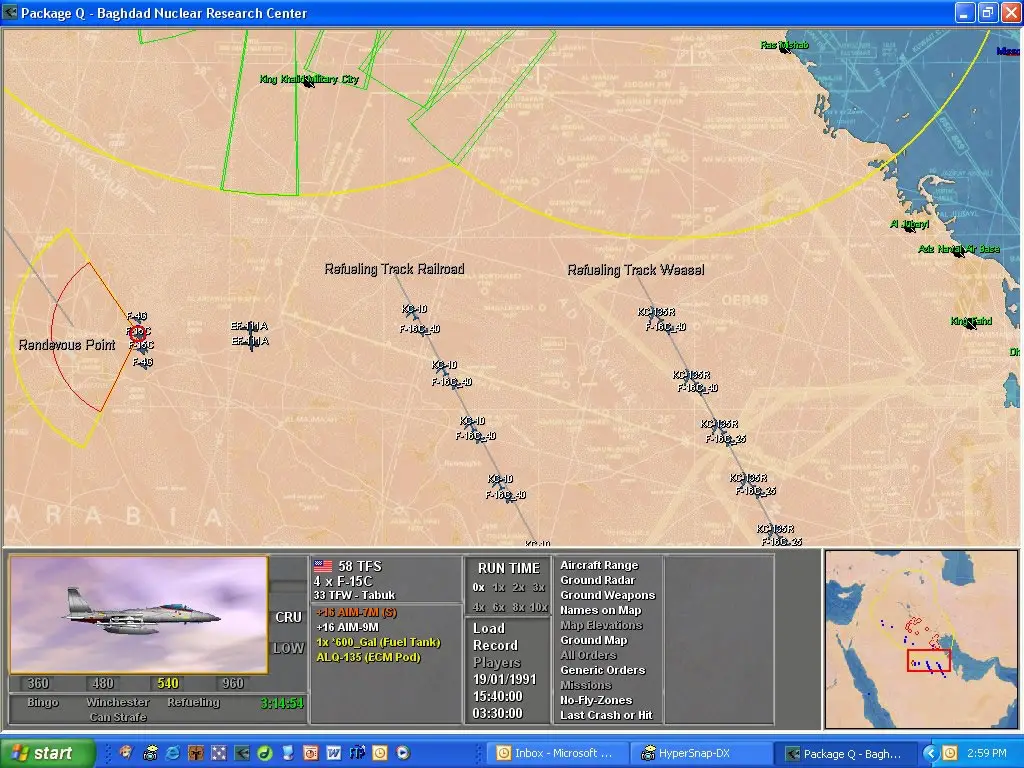
The U.S. Air Force had to go in an odd direction in order to get a wargame for teaching new officers what planning and running an air battle is like. Wargames (or "combat simulations") have become increasingly popular, and useful, as computers (and commercial war games) have become more powerful, and cheaper. In the last decade, the military has moved from creating its own wargames in-house, to simply (and much less expensively) adapting commercial wargames to professional use. The air force has been using flight simulators since the 1930s, and now a lot of commercial flight simulator technology is used in training military pilots. But while there are plenty of commercial wargames dealing with ground and naval combat, except for flight simulators, there was very little done on planning air campaigns and battles.
Posted: 09/01/2006
Discussion Board on this Photo
It works like this. While we tend to think of air combat as individual pilots dueling with each other, or trying to put bombs on a target, it's actually a lot more complicated than that. Air campaigns (or "Theater Air Operations") tend to involve hundreds of warplanes in the air at one time, all of them performing different jobs. Someone has to plan this ahead of time, and wargames are a perfect tool for this sort of thing. Unfortunately, few of the computer wargames out there deal with this. Mainly because the situation doesn't lend itself to the same kind of excitement of ground or naval combat. That's because after the "battle for air supremacy" is over, and one side basically controls the air, there's a different kind of challenge. At that point, planning and running the air battle becomes largely a logistical (supplying fuel, bombs and the like) and coordination job. That is, you want to use your resources (aircraft and air bases) as efficiently as possible in order to carry out the missions. These missions are mainly supporting the troops on the ground, but also reconnaissance and making sure your supremacy of the air remains in place.
The U.S. Air Force did, however, find a commercial wargame to (more cheaply) create a game that showed all the things involved when planning and executing large scale air ("theater") air operations. A commercial computer wargame, by designer John Tiller, called "Modern Air Power" was modified to meet air force requirements (more detail and the right jargon). This game was re-named "Theater Airpower Visualization" (TAV). In addition to contemporary operations, TAV came with databases showing past theater air operations, all the way back to Vietnam operations in the 1960s. Instructors could easily create new databases, and modify old ones.
TAV was mainly for teaching officers, in the classroom, how to actually plan and carry out theater air operations. They need something like TAV because the computer based tools used to sort out which aircraft to use for which job on which mission are quite complex and also classified. The students need something that can be learned quickly and played intuitively (without having to learn a lot of arcane rules and procedures). Students don't have many classroom hours for this sort of thing, so a game like TAV makes the most of the time available. That's the reason why so many of the army, navy and marine wargames are also easy to use and unclassified. While TAV is easy to learn and use, it is still quite different from a commercial product. For example, the air force added things like the Air Tasking Order (the computer generated list of what every aircraft would do every day during a campaign, based on the needs of all the combat forces out there). TAV also showed the complex relationships between various air force, and non-air force, organizations. In short, TAV allows all air force officers, not just pilots and those who might one day run these campaigns, to experience what planning and executing a battle plan is like.
The main point of a wargame is learning. Wargames are, by definition, competitive and rich in information. The wargame-like computer systems used to plan air campaigns (or land or naval ones) are more process, than gaming. Students who will actually do the planning of theater air operations, will learn all those administrative procedures in other classes. But when you want to teach them how to out-think the enemy, understand how the air force operates, and the limitations of existing aircraft, weapons and equipment, you need a competition based wargame like TAV.
The Vietnam Era and World War II Era Modern Airpower games can be purchased in the StrategyPage game store.
More Photos
1 |
2 |
3 |
4 |
5 |
6 |
7 |
8 |
9 |
10 |
11 |
12 |
13 |
14 |
15 |
16 |
17 |
18 |
19 |
20 |
21 |
22 |
23
